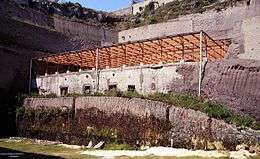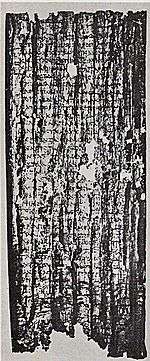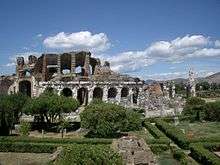Villa of the Papyri

Coordinates: 40°48′28″N 14°20′40″E / 40.8078°N 14.3445°E The Villa of the Papyri (Italian: Villa dei Papiri, also known as Villa dei Pisoni) is a private house in the ancient Roman city of Herculaneum (current commune of Ercolano, southern Italy).[1] Situated north-west of the township, the residence sits halfway up the slope of the volcano Vesuvius without other buildings to obstruct the view.[1] The villa suburbana was perhaps owned by Julius Caesar's father-in-law, Lucius Calpurnius Piso Caesoninus.[2]
In AD 79, the eruption of Vesuvius covered all of Herculaneum with some 30 m of volcanic ash. Its remains were first excavated in the years between 1750 and 1765 by Karl Weber by means of underground tunnels. Its name derives from the discovery of its library, the only surviving library from classical antiquity that exists in its entirety.[3] It had contained over 1,800 carbonized papyrus scrolls, the "Herculaneum papyri".
Ground plan and works of art

The villa's front stretched for more than 250 meters, parallel to the coastline of what is now called the Gulf of Naples. It was also surrounded by a garden closed off by porticoes, but with an ample stretch of vegetable gardens, vineyards and woods down to a small harbor. Sited a few hundred metres from the nearest house in Herculaneum, Piso's home had four levels disposed in a series of terraces on the sloping site, and was one of the most luxurious houses in all of Herculaneum and Pompeii. The villa also housed a collection of 80 sculptures of magnificent quality, many now conserved in the rooms of the large bronzes at the Naples National Archaeological Museum.[1] Among them is the bronze Seated Hermes, found at the villa in 1758.
The villa remains faithful in its general layout to the fundamental structural and architectural scheme of the suburban villa in the country around Pompeii. The atrium functioned as an entrance hall and a means of communication with the various parts of the house. The entrance opened with a columned portico on the sea side. Around the bowl of the atrium impluvium were 11 fountain statues depicting Satyrs pouring water from a pitcher and Amorini pouring water from the mouth of a dolphin. Other statues and busts were found in the corners around the atrium walls.[1]
The first peristyle had 10 columns on each side and a swimming bath in the center. In this enclosure were found the bronze herma of Doryphorus, a replica of Polykleitos' athlete, and the herma of an Amazon made by Apollonios son of Archias of Athens.[4] The large second peristyle could be reached by passing through a large tablinum in which, under a propylaeum, was the archaic statue of Athena Promachos. A collection of bronze busts were in the interior of the tablinum. These included the head of Scipio Africanus.[1]
The real living and reception quarters were grouped around the porticoes and terraces, giving occupants ample sunlight and a view of the countryside and sea. In the living quarters, bath installations were brought to light, and the library of rolled and carbonized papyri placed inside wooden capsae, some of them on ordinary wooden shelves and around the walls and some on the two sides of a set of shelves in the middle of the room.[1]
The grounds included a large area of covered and uncovered gardens for walks in the shade or in the warmth of the sun. The gardens included a gallery of busts, hermae and small marble and bronze statues. These were laid out between columns amid the open part of the garden and on the edges of the large swimming bath.[1]
Epicureanism and the library
The owner of the house, perhaps Calpurnius Piso, established a library of a mainly philosophical character. It is believed that the library might have been collected and selected by Piso's family friend and client, the Epicurean Philodemus of Gàdara - although his conclusion is not certain[2][5] Followers of Epicurus studied the teachings of this moral and natural philosopher. This philosophy taught that man is mortal, that the cosmos is the result of accident, that there is no providential god, and that the criterion of a good life is pleasure and temperance. Philodemus' connections with Piso brought him an opportunity to influence the young students of Greek literature and philosophy who gathered around him at Herculaneum and Naples. Much of his work was discovered in about a thousand papyrus rolls in the philosophical library recovered at Herculaneum. Although his prose work is detailed in the strung-out, non-periodic style typical of Hellenistic Greek prose before the revival of the Attic style after Cicero, Philodemus surpassed the average literary standard to which most epicureans aspired. Philodemus succeeded in influencing the most learned and distinguished Romans of his age. None of his prose work was known until the rolls of papyri were discovered among the ruins of the Villa of the Papyri.[2]

At the time of the eruption of Vesuvius in AD 79, the valuable library was packed in cases ready to be moved to safety when it was overtaken by pyroclastic flow; the eruption eventually deposited some 20–25 m of volcanic ash over the site, charring the scrolls but preserving them— the only surviving library of Antiquity— as the ash hardened to form tuff.[1]
Excavation
As of 2012, there are still 2,800 m² left to be excavated of this villa suburbana, the most luxurious in the resort of Herculaneum. Beneath the excavated area, new excavations in the 1990s revealed two previously undiscovered floors to the villa, which was built in a series of terraces overlooking the sea.
The reason that the remainder of the site has not been excavated is that the Italian government is practicing a policy of conservation and not excavation, and is more interested in protecting what has already been uncovered.[6] David Woodley Packard, who has funded conservation work at Herculaneum through his Packard Humanities Institute, has said that he is likely to be able to fund excavation of the Villa of the Papyri when the authorities agree to it; but no work will be permitted on the site until the completion of a feasibility report, which has been in preparation for some years. The first part of the report emerged in 2008 but included no timetable or cost projections, since the decision for further excavation is a political one.[7] Politics involve excavation under inhabited areas in addition to unspecified but reported[8] references to mafia involvement.
Using multi-spectral imaging, a technique developed in the early 1990s, it is possible to read the burned papyri. With multi-spectral imaging, many pictures of the illegible papyri are taken using different filters in the infrared or in the ultraviolet range, finely tuned to capture certain wavelengths of light. Thus, the optimum spectral portion can be found for distinguishing ink from paper on the blackened papyrus surface.
Non-destructive CT scans will, it is hoped, provide breakthroughs in reading the fragile unopened scrolls without destroying them in the process. Encouraging results along this line of research have been obtained, which use Phase-contrast X-ray imaging. [9] [10] [11] [12] According to authors, "this pioneering research opens up new prospects not only for the many papyri still unopened, but also for others that have not yet been discovered, perhaps including a second library of Latin papyri at a lower, as yet unexcavated level of the Villa."[13]
J. Paul Getty Museum
The original "Getty Villa", part of the J. Paul Getty Museum complex at Pacific Palisades, California is a free replication of the Villa of the Papyri, as it was published in Le Antichità di Ercolano. This museum building was constructed in the early 1970s by the architectural firm of Langdon and Wilson. Architectural consultant Norman Neuerburg and Getty's curator of antiquities Jiří Frel worked closely with J. Paul Getty to develop the interior and exterior details. Since the Villa of the Papyri was buried by the eruption and much of it remains unexcavated, Neuerburg based many of the villa's architectural and landscaping details on elements from other ancient Roman houses in the towns of Pompeii, Herculaneum, and Stabiae.[14]
With the move of the Museum to the Getty Center, the "Getty Villa" as it is now called, was renovated; it reopened on January 28, 2006.
In modern literature
Several scenes in Robert Harris' bestselling novel Pompeii are set in the Villa of the Papyri, just before the eruption engulfed it. The villa is mentioned as belonging to Roman aristocrat Pedius Cascus and his wife Rectina. (Pliny the Younger mentions Rectina, whom he calls the wife of Tascius, in Letter 16 of book VI of his Letters.) At the start of the eruption Rectina prepares to have the library evacuated and sends urgent word to her old friend, Pliny the Elder, who commands the Roman Navy at Misenum on the other side of the Bay of Naples. Pliny immediately sets out in a warship, and gets in sight of the villa, but the eruption prevents him from landing and taking off Rectina and her library — which is thus left for modern archaeologists to find.
See also
- Oxyrhynchus
- Friends of Herculaneum Society which encourages interest in the Villa and sponsors further excavation at the site.
References
- 1 2 3 4 5 6 7 8 9 Maiuri, Amedeo. Herculaneum and the Villa of the Papyri. Italy (1974): 35-39.
- 1 2 3 Hornblower, Simon and Antony Spawforth. Oxford Classical Dictionary. 3rd ed. New York (1996).
- ↑ "Archived copy". Archived from the original on October 30, 2015. Retrieved September 8, 2015.
- ↑ Stewart, Andrew. Greek Sculpture. Yale University Press (1990).
- ↑ See Erlend D. MacGillivray "The Popularity of Epicureanism in Late-Republic Roman Society" The Ancient World, XLIII (2012) 151-172.
- ↑ See conservation issues of Pompeii and Herculaneum.
- ↑ Feasibility Study
- ↑ In search of Western civilisation's lost classics, The Australian, August 6, 2008
- ↑ Vergano, Dan (January 22, 2015). "X-Rays Reveal Snippets From Papyrus Scrolls That Survived Mount Vesuvius". National Geographic.
- ↑ Bukreeva, I.; et al. (2016). "Enhanced X-ray-phase-contrast-tomography brings new clarity to the 2000-year-old 'voice' of Epicurean philosopher Philodemus". arXiv:1602.08071
 .
. - ↑ Mocella V, et al. (2015). "Revealing letters in rolled Herculaneum papyri by X-ray phase-contrast imaging" (PDF). Nature Communications. 6.
- ↑ Bukreeva I, et al. (2016). "Virtual unrolling and deciphering of Herculaneum papyri by X-ray phase-contrast tomography". Nature - Scientific Reports. 6.
- ↑ Mocella V, et al. (2015). "Revealing letters in rolled Herculaneum papyri by X-ray phase-contrast imaging" (PDF). Nature Communications. 6: 5.
- ↑ The Getty. 2005. J. Paul Getty Museum. 11 May 2007 http://www.getty.edu/visit/see_do/architecture.html.
Further reading
- David Sider, (2005), The Library of the Villa dei Papiri at Herculaneum. J. Paul Getty Museum. ISBN 0-89236-799-7
External links
| Wikimedia Commons has media related to Villa of the Papyri. |
- Papyri herculanensi online
- The Friends of Herculaneum Society
- Philodemus Project website
- Roman Herculaneum website
- "Millionaire to fund dig for lost Roman library", The Sunday Times (London) February 13, 2005
- American Society of Mechanical Engineers: Henry Baumgartner, "New light on ancient scrolls" 2002
- J. Paul Getty Museum
- In search of Western civilisation's lost classics, The Australian, August 6, 2008
- 2015 New Yorker article about the villa


